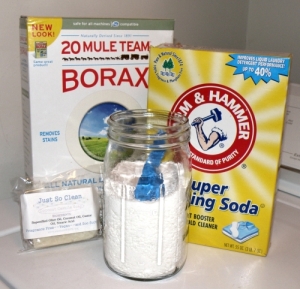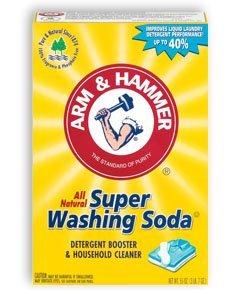Homemade Laundry Soap
 When making the switch to natural products, laundry detergent and fabric softeners play a key role. From the clothes we wear to our pillows and sheets, chemicals used in laundering come in contact with our skin 24 hours a day.
When making the switch to natural products, laundry detergent and fabric softeners play a key role. From the clothes we wear to our pillows and sheets, chemicals used in laundering come in contact with our skin 24 hours a day.
To get an idea of the types of chemicals found in products like detergents, see this article listing the most common chemicals found in 31 fragrance products.
Thankfully, there are many non-toxic options.
Soap nuts grow on the Chinese Soapberry Tree and are sometimes call soap berries. Soap nuts contain naturally occurring saponins, which foam when combined with water. Sources for soap nuts include Eco Nuts and Green Virgin.
Another alternative is to make your own laundry soap. Note that laundry soap will be more natural than detergent, as detergent is made from synthetics while soap is derived from natural elements.
Here are three simple recipes for homemade laundry soap.
Powdered Laundry Soap
This works nicely for high-efficiency (HE) machines because the suds are not overbearing like other powdered detergents. A little goes a long way with this recipe!
- 1 4-oz. bar castile soap or old-fashioned laundry soap made with animal fat (castile soap is a plant oil-based soap; laundry soap is not super-fatted and therefore a bit stronger. For a pure, fragrance-free castile soap, see our momsAWARE Online Store.)
- 1 c. borax (see our Borax: Friend or Foe? article for pertinent safety information)
- 1 c. washing soda *
Finely grate the soap bar and mix with borax and washing soda. To do this quickly and efficiently, purchase an inexpensive food processor for the sole purpose of making laundry soap. Process soap, add remaining ingredients, and mix. Store in an airtight container.
Use 1-2 tablespoons per wash, depending on the size of the load.
The powdered soap works best in warm/hot water. Some of the soap may not dissolve when used with cold water. Mix 1-2 tablespoons of the powder with warm water prior to washing or use liquid recipes below for gentle/cold cycles.
For added potency, add 1/2 c. baking soda to each load and 1/2 c. white vinegar during the rinse cycle.
* Washing soda is sodium carbonate. This is different from baking soda, which is sodium bicarbonate. Washing soda is higher on the pH scale than baking soda and therefore adds extra cleaning power. The higher pH also makes it an effective water softener. Washing soda can be found in the laundry aisle at many stores and is also available online. The most popular brand's packaging is pictured at right. (You can also make your own using baking soda; see How to Make Your Own Washing Soda for the recipe.)
Liquid Laundry Soap
Option 1:
- 2 1/4 c. liquid castile soap
- 3/4 c. water
- 1/4 c. white vinegar
- 1 tbsp. glycerin
- 10-15 drops essential oil (citrus scents work particularly well)
Combine all ingredients in jar or container. Shake before using. Use 1/4 c. per average washer load.
Option 2:
- 1 oz. castile soap (1/4 bar if using 4 oz. bar)
- 3 c. boiling water
- 1/4 c. washing soda
- 1/4 c. borax
- 10 c. water *
Grate castile soap and dissolve in boiling water. Add washing soda and borax. Stir until dissolved. Pour into large container (a 1 gallon glass jar works great). Add 10 c. water and stir. Let set for 24 hours, until it forms a liquid gel. Use 1/2 c. liquid soap for each load.
* Some recipes allow for more dilution. Feel free to add more than 10 c. water.

